MERIDIAN CHANNELS
Reference from http://www.rexmasseur.com
Pressure Points: A pressure point (Japanese: kyusho “vital point, tender spot”; Chinese: Malayalam marmam) in the field of martial arts refers to an area on the human body that may produce significant pain or other effects when manipulated in a specific manner.
Techniques of attacks on pressure points are called, Hyol Do Bup (Hangul:) in Korean martial arts, such as Hapkido, Sin Moo Hapkido, Han Mu Do, and kyusho-jutsu (Japanese) in various styles of Japanese martial arts, such as Jujutsu, Aikido, Tenjin Shinyo-ryu, Daito-ryu Aiki-jujutsu,Koto-ryu, Goju-ryu, Sekiguchi-ryu, Yoshin-ryu, Koga-ryu and Karate.
The concept of pressure points is present in old school (17th century) Japanese martial arts and is claimed to have an even earlier history; in a 1942 article in the Shin Budo magazine, Takuma Hisa Sensei asserted the existence of a tradition attributing the first development of pressure-point attacks to Shinra SaburoMinamoto no Yoshimitsu (1045–1127).Wuxia fiction, and became known by the name of Dim Mak or “Death Touch” in western popular culture from the 1960s. One of the best known uses of pressure-point fighting was known to Trekkies as the “Vulcan nerve pinch.” While it is undisputed that there are sensitive points on the human body where even comparatively weak pressure may induce significant pain or serious injury, the association of kyusho with esotericist notions of qi, acupuncture orreflexology is controversial.
Types
The nervous system more or less follows the Chinese meridians. There are several types of pressure points – each is applied differently and each creates a different effect. “Pain points”, for example, use tendons, ligaments, and muscles – the goal to temporarily immobilize the target, or at the very least to distract them. Reflex pointsproduce involuntary movements, for example causing the hand to release its grip, the knees to buckle, or the target to gag, or even for the person to be knocked unconscious. Most pressure points are located on pathways on the nervous system.
Pain
Some pressure points produce pain when struck, pressed, or rubbed depending on the point itself. These are also referred to as nerve centers. While the distraction of pain might offer sufficient advantage in a fight or escape, additionally the body has a Pain withdrawal reflex whereby it reacts to pain by moving away from the source. Martial artists can make use of this through minimal effort. Applying pressure to the collar bone from above will cause the subject to move downwards, whereas poking them upwards in the gap between the ear and neck will make their body want to move upwards. Pressure to the shoulder causes that side of the body to move back. A jabto the abdomen in the middle of the stomach will cause some people to twist around, away from the pain. A rapid impact – say from an elbow or fist – to the solar plexuscan easily knock all the air straight out of a victim, leaving them gasping for air and unable to move. Some points react more violently to pain from changes in the pressure (rubbing) rather than constant pressure. Applying pressure to the nose ortemple will also cause significant pain. Some other of these pressure points are: eyes, ears, throat, elbow joint, wrist, back of hand, collar bone, solar plexus, ribs, between shoulder blades, kidneys, groin, upper inner thigh, knee, shin, instep and Achilles tendon.
Blood and blood pressure
The baroreceptors in the carotid artery are pressure-sensitive, supplying the brain with information to control systemic blood pressure. Pressure against this region will send signals which indicate that blood pressure is too high and lead to a lowering of blood pressure. Therefore striking this area can cause unconsciousness using the same mechanism, also relying on the force being transmitted to the reticular activating system.
Break
There are certain areas which are likely to lead to a break if struck properly, such as the “floating ribs”, the philtrum, and the side of the knee.
Hyper-extension
There are joints that when struck, can be hyper-extended and even tear. This is a technique which can cause permanent damage to one’s opponent. There are two types:
Brute force: This takes advantage of the vulnerability of the strike point, usually a joint, thereby causing the damage.
Golgi organs: A relatively gentle strike to the Golgi tendon at the back of the elbow, for example, triggers a reflex which immediately relaxes that tendon allowing the elbow to bend more easily in the wrong direction. If this is immediately followed by a solid strike to the elbow joint, the elbow can be broken with significantly less effort than through brute force.
Concussion
The brain is a sensitive organ which floats in a fluid (cerebrospinal fluid). These safety mechanisms allowing the head to take substantial impact without resulting inconcussion, but which can still cause permanent brain damage. However, according to some martial arts, a blow can be delivered using techniques in a way that effectively eliminates such protections, thus causing disorientation or instantaneous knockout. The most commonly taught technique involves a strike just below theoccipital ridge, at the correct angle in the correct direction. Another well known point with this effect is the chin or lower jaw, giving rise to the boxing expression: a “glass jaw”. The same effect of knocking somebody unconscious may be achieved by using the edge of the hand (palm-up) to apply a sharp strike to the carotid artery. Arts such as Bak Mei and Bok Foo Pai utilize this strategy almost exclusively in combat.
The Touch of Death or Death Touch refers to any martial arts technique that can kill using seemingly less than lethal force targeted at specific areas of the body.
The concept known as Dim Mak, (simplified Chinese: ; traditional Chinese: ; pinyin: dianmài; literally “press artery”; Jyutping: dim mak), alternativelydianxuè (simplified Chinese: ??; traditional Chinese: ) traces its history to Traditional Chinese Medicine Acupuncture.
Tales of its use are often found in the Wuxia genre of Chinese martial arts fiction. Dim mak is depicted as a secret body of knowledge with techniques that attack pressure points and meridians, said to incapacitate or sometimes cause immediate or even delayed death to an opponent.
The concept known as Vibration Palm, originates with the Chinese martial arts Nei Jing (“internal”) energy techniques that deal with the Qi energy and the type of force (jin) used. It is depicted as “a technique that is part psychic and part vibratory, this energy is then focused into a wave”.
Acupuncture points (Chinese: or Chinese: , also called acupoints) are locations on the body that are the focus of acupuncture, acupressure, sonopuncture and laser acupuncture treatment. Several hundred acupuncture points are located, it is considered, along meridians (connected points across the anatomy which affect a specific organ or other part of the body). There are also numerous “extra points” not associated with a particular meridian.
Acupuncturists tend to perceive traditional Chinese medicine in functional rather than structural terms that is in being useful in guiding evaluation and care of patients. Despite considerable efforts to understand the anatomy and physiology of the “acupuncture points”, the definition and characterization of these points remains controversial. However research indicates they could be anatomically associated with fascial planes of connective tissue between muscles and associated with areas of low electrical impedance.
A 2005 systematic review found the effects of acupuncture on brain activation measured by functional magnetic resonance imaging and positron emission tomography caused “specific and largely predictable areas of brain activation and deactivation” and that these linked to “the traditional Chinese functions attributable to certain specific acupuncture points. For example, points associated with hearing and vision stimulates the visual and auditory cerebral areas respectively.”
Theory
Acupoints used in treatment may or may not be in the same area of the body as the targeted symptom. The Traditional Chinese Medicine (TCM) theory for the selection of such points and their effectiveness is that they work by stimulating the meridian system to bring about relief by rebalancing yin, yang and qi (also spelled “chi” or “ki”). This theory is based on the paradigm of TCM and has no analogue in western medicine.
Body acupoints are generally located using a measurement unit, called the cun, that is calibrated according to their proportional distances from various landmark points on the body. Acupoint location usually depends on specific anatomical landmarks that can be palpated. There are nearly 400 basic acupoints recognized by the WHO on the meridians. Many of these basic points are rarely used. Some points are considered more therapeutically valuable than others, and are used very frequently for a wide array of health conditions.
Location by palpation for tenderness is also a common way of locating acupoints (see also trigger point). Points may also be located by feeling for subtle differences in temperature on the skin surface or over the skin surface, as well as changes in the tension or “stickiness” of the skin and tissue. There is no scientific proof that this method works and some practitioners disagree with the method.
Body acupoints are referred to either by their traditional name, or by the name of the meridian on which they are located, followed by a number to indicate what order the point is in on the meridian. A common point on the hand, for example, is named Hegu, and referred to as LI 4 which means that it is the fourth point on the Large Intestine meridian.
Effects upon brain
Acupuncture appears to have distinct effects on cortical activity, as demonstrated by MRI (magnetic resonance imaging) and PET (positron emission tomography). Researchers from the University of Southampton, UK and Purpan Hospital of Toulouse, France, summarize the literature:
Investigating Acupuncture Using Brain Imaging Techniques: The Current State of Play: George T. Lewith, Peter J. White and Jeremie Pariente. “We have systematically researched and reviewed the literature looking at the effect of acupuncture on brain activation as measured by functional magnetic resonance imaging and positron emission tomography. These studies show that specific and largely predictable areas of brain activation and deactivation occur when considering the traditional Chinese functions attributable to certain specific acupuncture points. For example, points associated with hearing and vision stimulates the visual and auditory cerebral areas respectively.”
Categories of body acupuncture points
Certain acupuncture points are ascribed different functions according to different systems within the TCM framework.
Five Transporting Points system describes the flow of qi in the channels using a river analogy, and ascribes function to points along this flowline according to their location. This system describes qi bubbling up from a spring and gradually growing in depth and breadth like a river flowing down from a mountain to the sea.
Jing-well points represent the place where the qi “bubbles” up. These points are always the first points on the yin channels or last points on the yang channels and with exception of Kid-1 YongQuan all points are located on the tips of fingers and toes. The Nan Jing and Nei Jing described jing-well points as indicated for “fullness below the heart” (feeling of fullness in the epigastric or hypochondrium regions) and disorders of the zang organs (yin organs).
Ying-spring points are where the qi “glides” down the channel. The Nan Jing and Nei Jing described ying-spring points as indicated for heat in the body and change in complexion.
Shu-stream points are where the qi “pours” down the channel. Shu-stream points are indicated for heaviness in the body and pain in the joints, and for intermittent diseases.
Jing-river points are where the qi “flows” down the channel. Jing-river points are indicated for cough and dyspnoea, chills and fever, diseases manifesting as changes in voice, and for diseases of the sinews and bones.
He-sea points are where the qi collects and begins to head deeper into the body. He-sea points are indicated for counterflow qi and diarrhea, and for disorders resulting from irregular eating and drinking.
Five Phase Points ascribe each of the five phases – wood, fire, earth, metal and water – to one of the Five Transporting points. On the yin channels, the jing-well points are wood points, the ying-spring points are fire, shu-stream points are earth, jing-river points are metal, he-sea points are water points. On the yang channels, the jing-well points are metal, ying-spring are water, shu-stream are wood, jing-river points are fire and he-sea points are earth points. These point categories are then implemented according to Five Phase theory in order to approach the treatment of disease.
Xi-cleft points are the point on the channel where the qi and blood gather and plunge more deeply. These points are indicated in acute situations and for painful conditions.
Yuan-source points are points on the channel from where the yuan qi can be accessed.
Luo-connecting points are located at the point on the channel where the luo meridian diverges. Each of the twelve meridians have a luo point that diverges from the main meridian. There are also three extra luo channels that diverge at Sp-21, Ren-15 and Du-
1.Back-shu points lie on the paraspinal muscles either side of the spine. Theory says that the qi of each organ is transported to and from these points, and can be influenced by them.
Front-mu points are located in close proximity to the respective organ. They have a direct effect on the organ itself but not on the associated channel.
Hui-meeting points are a category of points that are considered to have a “special effect” on certain tissues and organs. The hui-meeting points are:
zang organs – Liv-13 Zhang Men
fu organs – Cv-12 Zhong Fu
qi – Cv-17 Shang Fu
blood – Bl-17 Ge Shu
sinews – GB-34 Yang Ling Quan
vessels – Lu-9 Tai Yuan
bone – Bl-11 Da Zhu
marrow – GB-39 Xuan Zhong
Non-meridian points
Additionally, there are microsystems of acupoints that are typically not located on the meridians. For example, auriculotherapy uses the external ear microsystem exclusively, utilizing thousands of points that are not on a meridian, but located on the surface of the external ear. The Korean system of hand acupuncture is a microsystem that utilizes acupoints on the hand. There are other common and uncommon acupoints that are called extra points, meaning that they are neither on a meridian nor part of a microsystem. Extra points are referred to more often by name, though some of the more commonly known have a letter/number combination for reference. A popular extra point is Yintang, located at the midpoint between the eyebrows.
Martial arts applications
There are several types of pressure points, each of which is applied differently, and each one creates different effects. Some of the principles are discussed below:
Pain: Some points are painful, because of the prevalence of nerves in the area. For example, being prodded in the throat is painful. The body has a pain withdrawal reflex, whereby it reacts to pain by moving away from it. Martial artists make use of this, sometimes without being aware of it. Applying pressure next to the collar bone, from above, will cause the person to move downwards (away from the pain), whereas poking them in the gap between the jaw and neck (just below the ear) will make their body want to move upwards. Pressure to the shoulder causes that side of the body to move back. A rub to the back down will cause the body to move forth. Some points react more violently to pain from changes in the pressure (rubbing) rather than constant pressure. All pressure points can cause pain but that may not be their true purpose.
Muscular: Here a direct attack is made on a muscle, which will contract. Examples include: (I) a punch to the solar plexus, which impacts the diaphragm and thus affects the person’s breathing (“getting the wind knocked out of you”); and (II) an attack to the outer thigh, which could cause the person to fall as their leg loses power (a “dead leg” or “charley horse”).
Pressure: The baroreceptor in the carotid artery is pressure-sensitive, allowing the body to control the bloodflow into the brain. Pressure against this region will ‘trick’ the body into thinking that blood pressure is too high, and thus will constrict and lower blood pressure – which can cause blackout. Striking veins and arteries can also cause them to shut or tear, both of which will definitely cause black-out and possible death if not treated immediately.
Break: There are certain areas which are likely to lead to a break if struck properly. This includes the “loose rib”, the philtrum and the top of the skull (soft-spot).
Hyper-Extension There are joints that, when struck, can be hyper-extended and even completely torn apart. This is a technique which can cause permanent damage and disfiguration to one’s opponent, usually focusing on the elbow and the knee. There are two types: brute force: This takes advantage of the vulnerability of the strike point, thereby causing the damage; and Golgi organs: A relatively gentle strike to the Golgi tendon at the back of the elbow, for example, causes a reflex which immediately relaxes that tendon, allowing the elbow to more easily bend in the wrong direction. If this is immediately followed by a solid strike to the elbow joint, the elbow can be broken with significantly less effort than through brute force.
Brain shake: The brain is actually a very vulnerable organ, which is why it is encased in the skull. The brain floats in fluid and balances on a very flexible spine. Certain techniques can actually shake the brain in a way which causes black out. The most commonly taught technique involves a strike just below the occipital ridge, at the correct angle in the correct direction. Other areas that are susceptible to such techniques are the temples and the top of the skull.
Energy: Some believe that there are energy channels which flow around the body through acupuncture meridians, and an attack will impact the flows, and thus impact the body. This is called “chi”, “ki” or “qi” in East Asian cultures. These techniques are said to be capable of causing blackout, serious injuries or death when used by a sufficiently skilled martial artist.
What is a “cun” measurement in the practice of acupuncture?
Because everybody occupies a unique physical form, there is no universal incremental measurement system for locating acupuncture points on an individual’s body. That is to say, that although approximate locations are known, the location of specific points will vary slightly on each person based on his or her relative size and physical dimensions. This is why the increment that is used to locate the acupuncture pressure points based on their relative distance from one another on a meridian is actually drawn from the individual’s body itself. The distance between the distal interphalangeal joint and the proximal interphalangeal joint on the middle finger of each individual is the increment known as “cun”. The cun is used to measure the distance between acupuncture points, and therefore locate the exact point based on its relative number of cun from other points. In this way, each individual has a unique cun increment used to locate acupuncture points on his or her own body. To precisely locate an acupoint, needs to know about Cun. Cun is the standard unit of measurement for the body used in acupuncture/acupressure.
Each individual has different body dimensions; Cun is defined according to the person who is to be treated.
1 cun = width of the thumb, in the middle, at the crease
3 cun = combined breadth of the 4 fingers, at the level of the pinky finger’s first joint above the palm of the hand
12 cun = the distance from the elbow crease to the wrist crease.
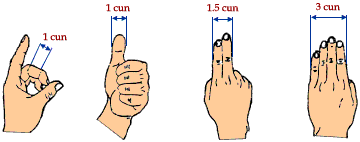
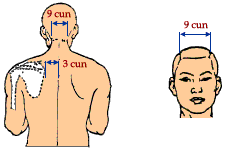
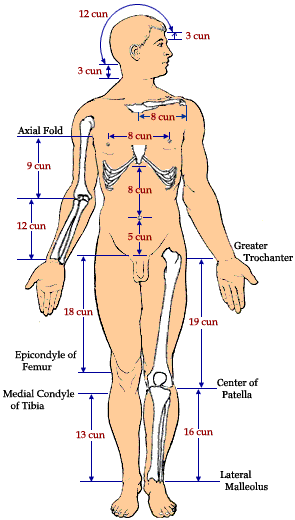
Acupuncture /Acupressure
The acupressure system of therapy uses the same points on the body as does acupuncture treatment to prevent diseases. “Acu” means care or precision, therapist takes care to use the exact point. However, instead of using needles to puncture the skin, the therapist uses hands, fingers, palms, elbows or feet, or special devices to place pressure on the points. So, when reference is made to acupressure points, remember that these are the same as acupuncture points.
The primary difference between acupressure and acupuncture is that the latter uses thin needles in addressing health concerns, while the former doesn’t break the skin. However, the two methods of holistic medicine have much in common, since they are both based on touching meridians that carry energy, or chi, throughout the body. In Traditional Chinese Medicine, illnesses are caused by blockages of chi somewhere along the meridians, so both acupressure and acupuncture encourage energy to flow freely once again.
One difference between acupressure and acupuncture arises in the specific application of the techniques. Acupuncture must be performed by a practitioner experienced in it. Several pressure points in specific combinations are accessed at the same time. The acupuncturist needs to reach bare skin therefore the patient usually to remove the clothing or covering prior to being treated.
Meridian Point Names and locations.
Lung Meridian Pathway & Point Locations
The Hand Greater Yin (Tai Yin) of the Lung has 11 points
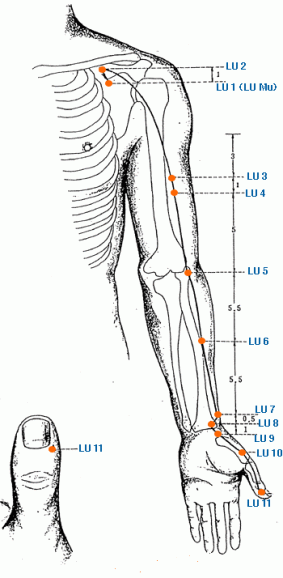
The lung channel of the Hand Taiyin originates from the lateral aspect of the chest near the arm pit. It then travels along the anterior-medial aspect of the upper arm, passing the cubital region and arrives at the radial side of the wrist containing the radial artery for pulse palpation. Passing the thenar eminence, it travels along the radial border of the palm ending at the medial side of the tip of the thumb.
LU1 Zhongfu
6 cun lateral to anterior midline level with the 1st intercostal space, 1 cun below LU 2. Caution: needle oblique to avoid lungs.
LU2 Yunmen
6 cun lateral to the anterior midline below the clavicle in the depression medial to the coracoid process. needle oblique to avoid lungs.
LU3 Tianfu
3 cun inferior to the anterior axillary fold on radial side of biceps brachii muscle.
LU4 Xiabai
4 cun inferior to the anterior axillary fold, 1 cun inferior to LU3 on radial side of biceps brachii muscle.
LU5 Chize
On the cubital crease, in the depression lateral to biceps brachii tendon.
LU6 Kongzui
7 cun above the transverse crease of the wrist.
LU7 Lieque
1.5 cun above the transverse crease of the wrist, superior to the styloid process of the radius.
LU8 Jingqu
1 cun above the transverse crease of the wrist in the hollow on the lateral side of the radial artery.
LU9 Taiyuan
On transverse crease of the wrist on the lateral side of the radial artery.
Large Intestine Meridian Pathway & Point Locations
The Hand Bright Yang (Yang MIng) of the Large Intestine 20 points
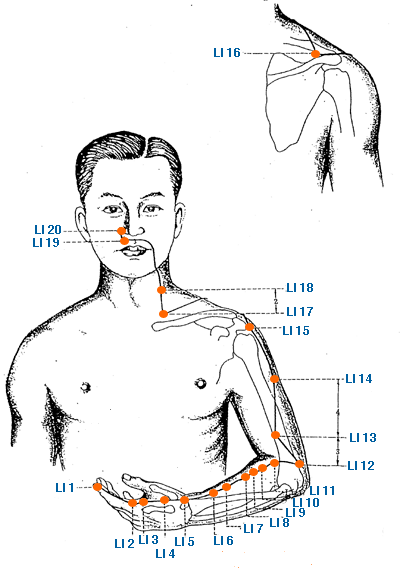
The large intestine channel of the Hang-Yangming starts from the tip of the index finger. Running upward along the radical aspect of the index finger, it passes through the inter-space of the first and second metacarpal bones, and ascends along the lateral anterior aspect of the upper arm to the highest point of the shoulder. It then travels along the anterior border of the acromion, then descends to the supraclavicular fossa. From the supraclavicular fossa it travels upward to the neck and to the cheek, then it curves around the upper lip and exits at the corner of the mouth, where it crosses the opposite large intestine channel of the Hand-Yangming at the philtrum. it ends at the side of the nose, where is connects with the stomach channel of the Foot-Yangming
LI1 Shangyang
0.1 cun posterior to the corner of the nail on the radial side of the index finger.
LI2 Erjian
On the radial side of the index finger distal to the 2nd metacarpal-phalangeal joint in a depression at the junction of the red & white skin.
LI3 Sanjian
On the radial side of the index finger proximal to the head of the 2nd metacarpal bone.
LI4 Hegu
On the dorsum of the hand, between the 1st and 2nd metscarpal bones.
LI5 Yangxi
On the radial side of the wrist between the extensor pollicis longus & brevis tendons in a depression formed when the thumb is tilted upward (anatomical snuffbox)
LI6 Pianli
3 cun above the transverse crease of the wrist (LI5) on the radial side of the forearm.
LI7 Wenliu
5 cun above the transverse crease of the wrist (LI5) on the radial side of the forearm.
LI8 Xialian
4 cun below LI 11 on the radial side of the forearm on the line connecting LI5 and LI11
LI9 Shanglian
3 cun below LI 11 on the radial side of the forearm on the line connecting LI5 and LI11
LI10 Shousanli
2 cun below LI 11 on the radial side of the forearm on the line connecting LI5 and LI11
LI11 Quchi
With a bent elbow, the point lies in the depression at the lateral end of the transverse cubital crease, midway between LU5 and the lateral epicondyle of the humerus.
LI12 Zhouliao
With the elbow flexed, on the radial side of the upper arm 1 cun above and lateral to LI11 on the lateral/posterior border of the humerus.
LI13 Shouwuli
3 cun above LI11 on the line connecting LI11 and LI15 line. Avoid injuring artery when needling!
LI14 Binao
4 cun above LI13 at the inferior border of the deltoid, on the line connecting LI11 and LI15.
LI15 Jianyu
Anterior and inferior to the acromion, on the upper portion of the deltoid muscle, in a depression formed when the arm is in full abduction.
LI16 Jugu
Slightly posterior to the shoulder, in the depression between the acromion process and the scapular spine.
L17 Tianding
On the lateral side of the neck, 1 cun below LI 18 on the posterior border of the SCM muscle.
LI18 Futu
On the lateral sid of the neck, level with the tip of the Adam’s Apple between the sternal head and the clavicular head of the SCM
LI19 Kouheliao
Directly below the lateral margin of the nostril 0.5 cun lateral to GV 26.
LI20 Yingxiang
In the nasolabial sulcus, level with the midpoint of the lateral border of the ala nasi.
Stomach Meridian Pathway & Point Locations
The Foot Bright Yang (Yang MIng) of the Stomach 45 points
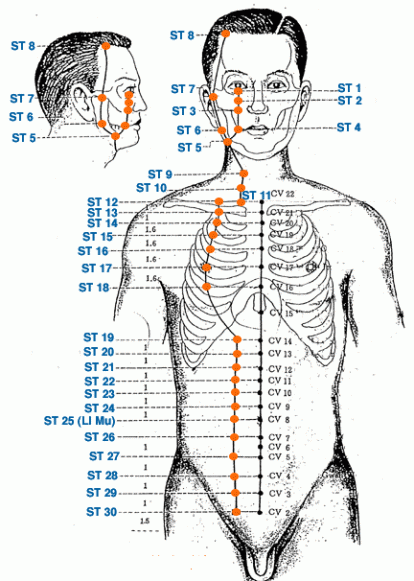

The stomach channel of the Foot-Yangming starts directly below the pupil between the eyeball and the infraorbital ridge. Running downward along the lateral side of the nose, to the lateral corner of the mouth. Curving posterior to the anterior angle of the mandible. Then it travels to the posterior aspect of the mandible ascending in front of the ear and following the anterior hairline, it reaches the forehead. It then runs along the throat and enters the supraclavicular fossa. The straight line of the channels separates the supraclavicular fossa and runs downward along the middle mammillary line. It travels to the side of the umbilicus and descends to the inguinal groove. Running downward it travels along the anterior aspect of the thigh and reaches the knee. From there is continues further down along the anterior border of the lateral aspect of the tibia to the dorsum of the foot and reaches the lateral side of the tip of the second toe.
ST1Chengqi
Directly below the pupil between the eyeball and the infraorbital ridge.
ST2 Sibai
Directly below the pupil in a depression at the infraorbital foramen.
ST3 Juliao
Directly below the pupil in a depression level with the lower border of the ala nasi.
ST4 Dicang
Directly below the pupil lateral to the corner of the mouth.
ST-4 Use with Cosmetic Acupuncture
Helps with: Eyelid spasm, lip spasm, tone facial muscles, mouth deviation, mouth ulcers, excessive salivation and lockjaw.
ST5 Jiache
Anterior to the angle of the mandible on the anterior border of the masseter muscle in a groove like depression when the cheek is bulged.
ST6 Jiache
One finger width anterior and superior to the lower angle of the mandible, at the prominence of masseter muscle.
ST7 Xiaguan
Anterior to the ear, with mouth closed, in the depression at the lower border of the zygomatic arch, anterior to the condyloid process of the mandible.
ST8 Touwei
At the corner of the forehead, 0.5 cun within the hairline at the corner of the forehead, 4.5 cun lateral to the midline at GV24.
ST9 Renying
Level with the tip of the Adam’s Apple on the anterior border of the SCM. Avoid puncturing common carotid artery.
ST10 Shuitu
Midway between ST9 and ST11 at the anterior border of the SCM.
ST11 Qishe
At the superior border of the medial end of the clavicle between the sternal head and the clavicular head of the SCM.
ST12 Quepen
In the midpoint of the supraclavicular fossa 4 cun lateral to the midline.
ST13 Qihu
In the infraclavicular fossa, 4 cun lateral to the midline, below ST12.
ST14 Kufang
4 cun lateral to the midline in the 1st intercostal space.
ST15 Wuyi
4 cun lateral to the midline in the 2nd intercostal space.
ST16 Yingchuang
4 cun lateral to the midline in the 3rd intercostal space.
ST17 Ruzhong
4 cun lateral to the midline in the 4th intercostal space in the center of the nipple. Contraindicated to needle and moxabustion!
ST18 Rugen
4 cun lateral to the midline in the 5th intercostal space.
ST19 Burong
2 cun lateral to the midline lateral to CV14, 6 cun above the umbilicus.
ST20 Chengman
2 cun lateral to the midline lateral to CV13, 5 cun above the umbilicus.
ST21 Liangmen
2 cun lateral to the midline lateral to CV12, 4 cun above the umbilicus.
ST22 Guanmen
2 cun lateral to the midline lateral to CV11, 3 cun above the umbilicus.
ST23 Taiyi
2 cun lateral to the midline lateral to CV10, 2 cun above the umbilicus.
ST24 Huaroumen
2 cun lateral to the midline lateral to CV9, 1 cun above the umbilicus.
ST25 Tianshu
2 cun lateral to the midline lateral to CV8 at the level of the umbilicus.
ST26 Wailing
2 cun lateral to the midline lateral to CV7, 1 cun below the umbilicus.
ST27 Daju
2 cun lateral to the midline lateral to CV5, 2 cun below the umbilicus.
ST28 Shuidao
2 cun lateral to the midline lateral to CV4, 3 cun below the umbilicus.
ST29 Guilai
2 cun lateral to the midline lateral to CV3, 4 cun below the umbilicus.
ST30 Qichong
2 cun lateral to the midline lateral to CV2, level with symphysis pubis.
ST31 Biguan
With the thigh flexed, in the depression lateral to the sartorius muscle, directly inferior to the anterior superior iliac spine (ASIS).
ST32 Futu
6 cun above the superior lateral border of the patella on line connecting the ASIS.
ST33 Yinshi
3 cun above the superior lateral border of the patella on line connecting the ASIS found with knee flexed.
ST34 Liangqiu
2 cun above the superior lateral border of the patella on line connecting the ASIS found with knee flexed.
ST35 Dubi
Below the patella in a depression lateral to the patella ligament found with knee flexed.
ST36 Zusanli
3 cun below ST35 one finger width lateral from the anterior crest of the tibia, in the tibialis anterior muscle.
ST37 Shangjuxu
3 cun below ST36 one finger width lateral from the anterior crest of the tibia.
ST38 Tiaokou
5 cun below ST36 one finger width lateral from the anterior crest of the tibia.
ST39 Xiajuxu
1 cun below ST38 one finger width lateral from the anterior crest of the tibia.
ST40 Fenglung
8 cun superior to the tip of the external malleous, one finger width lateral to ST38.
ST41 Jiexi
On the dorsum of the foot at the midpoint of the transverse crease of the ankle joint, approximately level with the tip of the external malleolus in a depression between the extensor digitorum longs and hallucis longus tendons.
ST42 Chongyang
On the dorsum of the foot, 1.5 cun inferior to ST41, in the depression between the second and third metatarsals and cuneiform bone. Avoid the dorsal artery when needling.
ST43 Xiangu
In a depression distal to the junction of the 2nd and 3rd metatarsal bones.
ST44 Neiting
At the proximal end of the web between the 2nd and 3rd toes in the depression distal and lateral to the 2nd metatarsodigital joint.
ST45 Lidui
0.1 cun posterior to the corner of nail on the lateral side of the 2nd toe
Spleen Meridian Pathway & Point Locations
The Foot Greater Yin (Tai Yin) of the Spleen 21 points
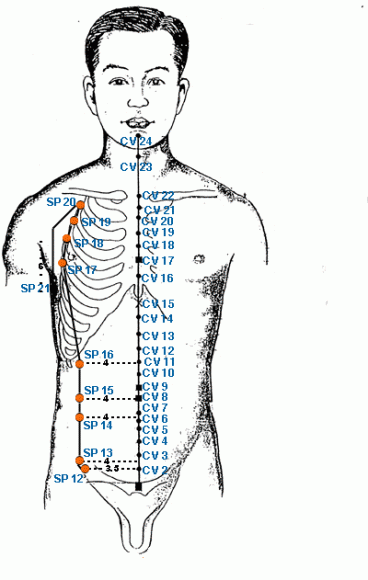
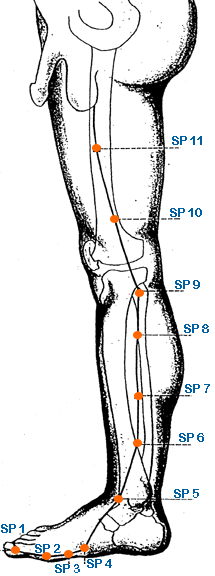
The spleen of the Foot-Taiyin starts from the medial aspect of the tip of the big toe. It travels along the medial aspect of the foot at the junction between the red and white skin, ascends anteriorly to the medial malleolus up to the medial aspect of the leg. Passing through the anterior medial aspect of the thigh, it enters the inguinal region traveling along the anterior of the abdomen. It then curves lateral to the midline to the intercostal space up to the 2nd intercostal space. Then turns inferior to midway between the axilla and the free end of the eleventh rib.
SP1 YinBai
0.1 cun posterior to the corner of the nail, on the medial side of the great toe.
SP2 Dadu
On medial side of the great toe, distal and inferior to the 1st Metatarsophalangeal joint in a depression at the juncture of the red and white skin.
SP3 Taibai
Proximal and inferior to the head of the 1st metatarsal bone in a depression at the junction of the red and white skin.
SP4 Gongsun
In a depression distal and inferior to the 1st metatarsal bone at the junction of the red and white skin.
SP5 Shangqui
In a depression distal and inferior to the medial malleolus, midway between the tuberosity of the navicular bone and the tip of the medial malleolus.
SP6 Sanyinjiao
3 cun directly above the tip of the medial malleolus on the posterior border of the tibia. Contraindicated to needle during pregnancy.
SP7 Lougu
6 cun from the tip of the medial malleolus on line connecting tip of medial malleolus and SP9 on the posterior border of the tibia (3 cun above SP6)
SP8 Diji
3 cun below SP9 on line connecting SP 9 and medial malleolus.
SP9 Yinlingquan
On the lower border of the medial condyle of the tibia, in the depression between the posterior border of the tibia and gastrocnemius muscle.
SP10 Xuehai
With the knee in flexion, 2 cun superior to the superior border of the patella, on the buldge of the medial portion of the quadraceps femoris muscle.
SP11 Jimen
6 cun above SP10 on the line connecting SP12 and SP10.
SP12 Chongmen
3.5 cun lateral to the midline at CV2, in the inguinal region, on the lateral side of the femoral artery. Avoid femoral artery when needling!
SP13 Fushe
0.7 cun laterosuperior to SP12 and 4 cun lateral to the anterior midline.
SP14 Fujie
1.3 cun below SP15 and 4 cun lateral to the anterior midline, on lateral side of rectus abdominis muscle.
SP15 Daheng
4 cun lateral to the center of the umbilicus, lateral to rectus abdominus muscle.
SP16 Fuai
3 cun above SP 15 and 4 cun lateral to the anterior midline at CV11.
SP17 Shidou
6 cun lateral to the anterior midline in the 5th intercostal space.
SP18 Tianxi
6 cun lateral to the anterior midline in the 4th intercostal space.
SP19 Xiongxiang
6 cun lateral to the anterior midline in the 3rd intercostal space.
SP20 Zhourong
6 cun lateral to the anterior midline in the 2nd intercostal space.
SP21 Dabao
On the midaxillary line, 6 cun inferior to the anterior axillary crease. Midway between the axilla and the free end of the eleventh rib
Heart Meridian Pathway & Point Locations
The Hand Lesser Yin (Shao Yin) of the Heart 9 points
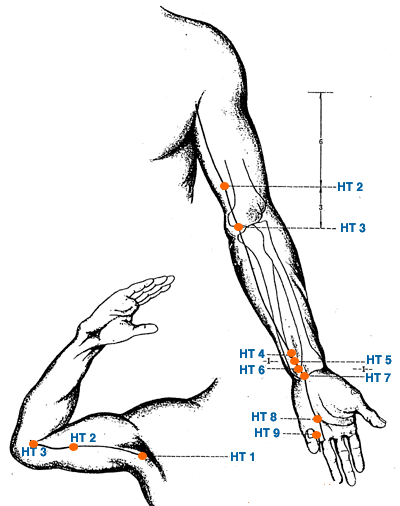
The heart channel of the Hand-Shaoyin starts in the center of axilla. From there is goes along the posterior border of the medial aspect of the upper arm . Passing through the cubital region, it descends to the pisiform region proximal to the palm and enters the palm. Then it ends at the medial aspect of the tip of the little finger.
HT1 Jiquan
Center of axilla on the medial side of the axillary artery. Avoid axillary artery!
HT2 Qingling
With elbow flexed, the point is found 3 cun above the medial end of the transverse cubital crease in the groove medial to the biceps brachii.
HT3 Shaohai
With elbow flexed, at the medial end of the transverse cubital crease.
HT4 Lingdao
With the palm facing up, the point is found 1.5 cun above the transverse crease of the wrist at HT7.
HT5 Tongli
1 cun above HT 7 on a line connecting HT3 and HT7.
HT6 Yinxi
0.5 cun above HT 7 on a line connecting HT3 and HT7.
HT7 Shenmen
On the ulnar end of the transversecrease of the wrist, in the small depression between the pisiform and ulna bones.
HT8 Shaofu
With a fist made, where the little finger falls between the 4th and 5th metacarpal bones.
HT9 Shaochong
0.1 cun posterior to the corner of the nail on the radial side of the little finger.
Small Intestine Meridian Pathway & Point Locations
The Hand Greater Yang (Tai Yang) of the Small Intestine 19 points
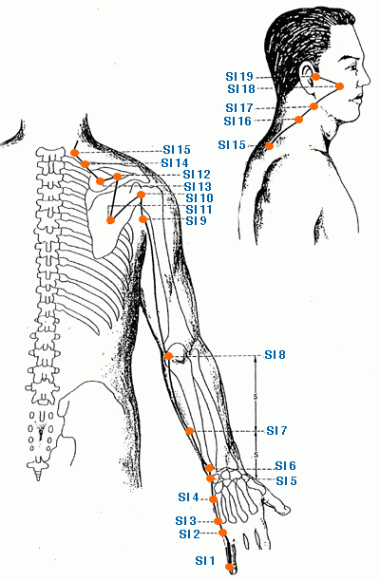
The small intestine channel of the Hand-Taiyang starts at the ulnar aspect of the tip of the little finger, and travels along the ulnar border of the hand dorsum upward to the posterior border of the lateral aspect of the upper arm. It passes through the cubital region curving around the scapular region. Then turning downward to the supraclavicular fossa and ascends to the neck. Travels up to the cheek going through the outer canthus of the eye, and ends anterior to the tragus of the ear.
SI1 Shaoze
0.1 cun posterior to the corner of the nail on the ulnar side of the little finger.
SI2 Qiangu
With a loose fist made the point is found on the ulner side of the fifth digit, in the depression distal to the metacarpophalangeal joint, at the junction of the red and white skin.
SI3 Houxi
With a loose fist made, In the depression proximal to the head of the fifth metacarpal bone, at the junction of the red and white skin.
SI4 Wangu
On the ulnar edge of the palm, in the depression between the fifth metacarpal bone and the hamate and pisiform bones.
SI5 Yanggu
Near the ulnar end of the transverse wrist crease on the dorsal side of the hand in a depression between the styloid process of the ulna and the triquetral bone.
SI6 Yanglao
On the dorsal side of the wrist, in the bony cleft on the radial side of the styloid process of the ulna.
SI7 Zhizheng
5 cun above SI5 on a line connecting SI 5 and SI8, between the anterior border of the ulna and flexor carpi ulnaris muscle.
SI8 Xiaohai
With elbow flexed, in a depression between the olecranon process of the ulna and the medial epicondyle of the humerus.
SI9 Jianzhen
With arm abducted, 1 cun above the posterior end of the axillary fold, posterior and inferior to the shoulder joint.
SI10 Naoshu
With arm abducted, directly above SI9 in a depression inferior to scapular spine.
SI11 Tianzong
In the depression of the the infrascapular fossa, one-third the distance between the lower border of the scapular spine and the inferior angle of the scapula, approximately level with T4 spinous process.
SI12 Bingfeng
Above SI11 in the center of the suprascapular fossa, in a depression when arm is lifted.
SI13 Quyaun
On the medial extremity of the suprascapular fossa, about midway between SI10 and the spinous process of T2.
SI14 Jianwaishu
3 cun lateral to the lower border of the spinous process of T1 (GV 13).
SI15 Jianzhongzhu
2 cun lateral from the posterior midline below the spinous process of C7 (GV 14).
SI16 Tianchuang
On lateral neck posterior to SCM, posterior and superior to LI18 level with the adams apple.
SI17 Tianrong
Posterior to the angle of the mandible in a depression on the anterior border of the SCM.
SI18 Quanliao
Directly below the outer canthus of the eys in a depression on the lower border of the zygoma. Contraindicated to moxabustion!
SI19 Tinggong
Anterior to the tragus and posterior to the condyloid process of the mandible in a depression formed when mouth is opened.
Bladder Meridian Pathway & Point Locations
The Foot Greater Yang (Tai Yang) of the Bladder 67 points
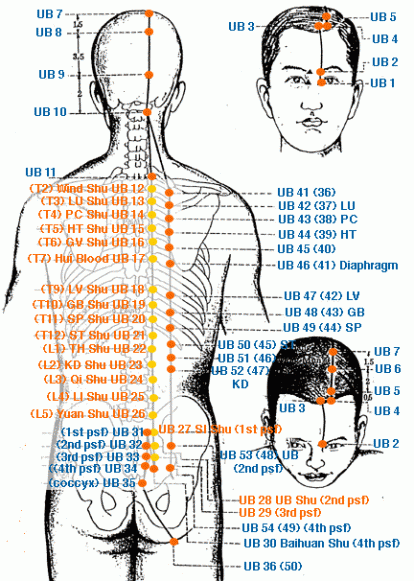
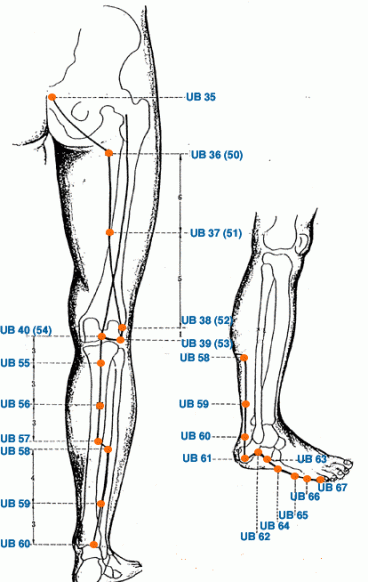
The urinary bladder channel of the Foot-Taiyang originates from the inner canthus of the eye. Passing through the forehead, it flows up to the vertex. It bifurcates above the posterior hairline into two lines. One line runs from the posterior aspect of the neck downward along the medial border of the scapula (3 cun lateral to the back mid-line). Passing through the gluteal region. Another line runs straight downward (1.5 cun lateral to the mid-line of the back) to the lumbar region. From there it descends along the posterior aspect of the thigh to the popliteal fossa. Descending to the posterior aspect of the gastrocnemius muscle and further to the posterior inferior aspect of the lateral malleolus. Ending at lateral posterior side of the tip of the little toe.
BL1 Jingming
0.1 cun superior to the inner canthus. of the eye in a depression
BL2 Zanzhu
In the supraorbital notch at the medial end of the eyebrow.
BL3 Meichong
0.5 cun within the anterior hairline directly above BL2 and 0.5 cun lateral to GV24.
BL4 Quchai
1.5 cun lateral to GV24 and 0.5 cun within the anterior hairline.
BL5 Wuchu
0.5 cun above BL4 or 1 cun above the anterior hairline and 1.5 cun lateral to GV23.
BL6 Chengguang
1.5 cun posterior to BL5 and 2.5 cun above the anterior hairline, 1.5 cun lateral to the midline.
BL7 Tongtian
1.5 cun posterior to BL6 and 4 cun above the anterior hairline, 1.5 lateral to the midline.
BL8 Luoque
1.5 cun posterior to BL7, 1.5 cun lateral to the midline.
BL9 Yuzhen
1.3 cun lateral to GV 17, on the lateral side of the superior border of the external occipital protuberance.
BL10 Tianzhu
1.3 cun lateral to GV15 and 0.5 cun above the posterior hairline, in a depression on the lateral aspect of the trapezius muscle.
BL11 Dazhu
1.5 cun lateral to GV13 level with the spinous process of T1. (from the midline to the medial border of the scapula is considered 3 cun)
BL 11 is known as the “Influential Point of Bone”. Two fingers breadth bilateral to C7-T1. Probably one of the most controversial points on the body due to the fact it does indeed have an effect on bone, but primarily due to its effect with pathogenic wind. When a patient complains of bone symptomatology due to attack of pathogenic wind as in “bi patterns” this point has a particularly high effect rate. However, it must be borne in mind, additional points such as BL 12, GB 21, TH 15 have very similar effects.
Read the full article The Eight (Hui) Influential Points.
BL12 Fengmen
1.5 cun lateral to midline level with the spinous process of T2.
BL13 Feishu
1.5 cun lateral to GV12 level with the spinous process of T3.
BL14 Jueyinshu
1.5 cun lateral to midline level with the spinous process of T4.
BL15 Xinshu
1.5 cun lateral to GV11 level with the spinous process of T5.
BL16 Dushu
1.5 cun lateral to GV10 level with the spinous process of T6.
BL17 Geshu
1.5 cun lateral to GV9 level with the spinous process of T7.
BL18 Gan Shu
1.5 cun lateral to GV 8 level with the spinous process of T9.
BL19 Danshu
1.5 cun lateral to GV 7 level with the spinous process of T10.
BL20 Pishu
1.5 cun lateral to GV 6 level with the spinous process of T11.
BL21 Weishu
1.5 cun lateral to midline level with the spinous process of T12.
BL22 Sanjiaoshu
1.5 cun lateral to GV5 level with the spinous process of L1.
BL23 Shenshu
1.5 cun lateral to GV4 level with the spinous process of L2.
BL24 Qihaishu
1.5 cun lateral to midline level with the spinous process of L3.
BL25 Dachangshu
1.5 cun lateral to GV3 level with the spinous process of L4.
BL26 Guanyuanshu
1.5 cun lateral to midline level with the spinous process of L5.
BL27 Xiaochangshu
1.5 cun lateral to midline level with the first posterior sacral foramen.
BL28 Pangguangshu
1.5 cun lateral to midline level with the second posterior sacral foramen.
BL29 Zhonglushu
1.5 cun lateral to midline level with the third posterior sacral foramen.
BL30 Baihuanshu
1.5 cun lateral to midline level with the fourth posterior sacral foramen.
BL31 Shangliao
In the first posterior sacral foramen.
BL32 Ciliao
In the second posterior sacral foramen.
BL33 Zhongliao
In the third posterior sacral foramen.
BL34 Xialiao
In the fourth posterior sacral foramen.
BL35 Huiyang
0.5 cun lateral to either side of the tip of the coccyx.
BL36 Fufen (AKA BL41)
3 cun lateral to the midline level with the spinous process of T2 on the spinal border of the scapula.
BL37 Pohu (AKA BL42)
3 cun lateral to GV12 level with the spinous process of T3 on the spinal border of the scapula.
BL38 Gaohuanshu (AKA BL43)
3 cun lateral to midline level with the spinous process of T4
BL39 Shentang (AKA BL44)
3 cun lateral to GV11 level with the spinous process of T5
BL40 Yixi (AKA BL45)
3 cun lateral to GV10 level with the spinous process of T6
BL41 Geguan (AKA BL46)
3 cun lateral to GV9 level with the spinous process of T7
BL42 Hunmen AKA BL47)
3 cun lateral to GV8 level with the spinous process of T9
BL43 Yanggang (AKA BL48)
3 cun lateral to GV7 level with the spinous process of T10
BL44 Yishe (AKA BL49)
3 cun lateral to GV6 level with the spinous process of T11
BL45 Weicang (AKA BL50)
3 cun lateral to midline level with the spinous process of T12
BL46 Huangmen (AKA BL51)
3 cun lateral to GV 5 level with the spinous process of L1
BL47 Zhishi (AKA BL52)
3 cun lateral to GV4 level with the spinous process of L2
BL48 Baohuang (AKA BL53)
3 cun lateral to the midline, at the level of the second sacral foramen.
BL49 Zhibian (AKA BL54)
3 cun lateral to the midline, at the level of the fourth sacral foramen.
BL50 Chengfu (AKA BL36)
On the posterior side of the thigh at the midpoint of the inferior gluteal crease
BL51 Yinmen (AKA BL37)
On the posterior thigh, 6 cun inferior to BL50, on a line joining BL50 and BL54.
BL52 Fuxi (AKA BL38)
With the knee in slight flexion, in the popliteal fossa, 1 cun superior to BL53 and on the medial side of biceps femoris tendon
BL53 Weiyang (AKA BL39)
Lateral to BL54 at the popliteal crease and medially to the becips femoris tendon.
BL54 Weizhong (AKA BL40)
Midpoint of the transverse crease of the popliteal fossa between the biceps femoris and semitendinosus tendons
BL55 Heyang
2 cun directly below BL54 between the medial and lateral heads of the gastrocnemius muscle on line connecting BL54 and BL57.
BL56 Chengjin
On the posterior leg, 5 cun inferior to BL54, in the center of the gastrocnemius muscle, along the line connecting BL54 and BL57.
BL57 Chengshan
In a depression below the gastrocnemius muscle, 8 cun inferior to BL54.
BL58 Feiyang
7 cun above BL60 on the posterior border of the fibula about 1 cun lateral and inferior to BL57.
BL59 Fuyang
3 cun directly above BL60.
BL60 Kunlun
In a depression between the tip of the lateral malleolus and the achilles tendon. Contraindicated to needle during pregnancy.
BL61 Pucan
Posterior and inferior to the lateral malleolus, directly below BL60, In a depression on the lateral calcaneus.
BL62 Shenmai
In a depression directly below the lateral malleolus.
BL63 Jinmen
Anterior and inferior to BL 62, In the depression posterior to the fifth metatarsal bone.
BL64 Jinggu
Below the tuberosity of the 5th metatarsal bone at the junction of the red and white skin.
BL65 Shugu
Posterior to the head of the 5th metatarsal bone at the junction of the red and white skin.
BL66 Zutonggu
In a depression anterior to the 5th metatarsophalangeal joint.
BL67 Zhiyin
0.1 cun posterior to the corner of the nail on the lateral side of the small toe. contraindicated to needle during pregnancy
Kidney Meridian Pathway & Point Locations
The Foot Lesser Yin (Shao Yin) of the Kidney 27 points
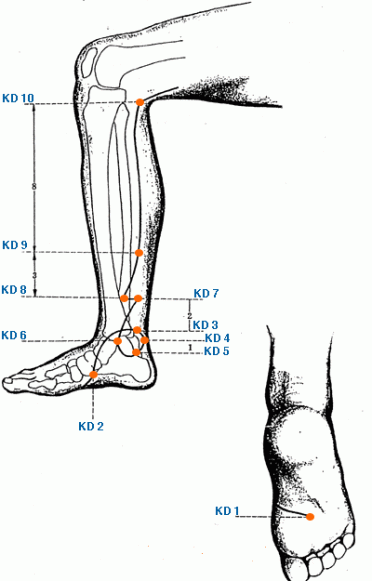
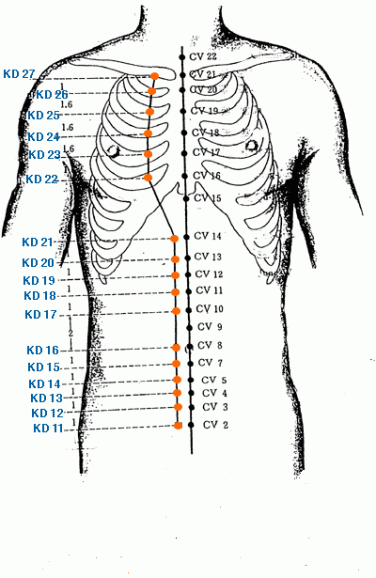
The kidney channel of the Foot-Shaoyin starts from the interior aspect of the little toe (On the sole of the foot, depending on the text.), and runs through a depression in the lower aspect of the tuberosity of the navicular bone. It travels behind the medial malleolus and encircles the malleolus. Ascending along the medial side of the leg, it passes the medial side of the popliteal fossa and goes further upward along the posterior-medial aspect of the thigh. Traveling to the superior border of the symphysis pubis forming a straight line 0.5 cun from the midline. It ascends diverging at the diaphragm, ending In a depression on lower border of clavicle 2 cun from the midline.
KI1 Yongquan
On the sole of the foot, in a depression when the foot is in plantar flexion at the junction of the anterior 1/3 and posterior 2/3 of line connecting base of 2nd and 3rd toes and the heel.
KI2 Rangu
Anterior and Inferior to the medial malleolus in a depression on the lower border of the tuberosity of the navicular bone.
KI3 Taixi
In depression midway between the tip of the medial malleolus and the attachment of the achilles tendon, level with the tip of the medial malleolus.
KI4 Dazhong
Posterior and inferior to the medial malleolus in a depression anterior to the medial attachment of the achilles tendon.
KI5 Shuiquan
1 cun directly below KI3 in a depression anterior and superior to the medial tuberosity of the calcaneus.
KI6 Zhaoha
i In a depression 1 cun below the tip of the medial malleolus.
KI7 Fuliu
2 cun above KI3 on the anterior border of the achilles tendon.
KI8 Jiaoxin
0.5 cun anterior to KI7, 2 cun above KI3, posterior to the medial border of the tibia.
KI9 Zhubin
5 cun above KI3 on the line drawn from KI3 to KI10 at the lower border of the gastrocnemius muscle.
KI10 Yingu
at the medial side of the popliteal fossa when the knee is flexed, between the tendons of semitendinosus and semimembranosus muscles level with BL54.
KI11 Henggu
At the superior border of the symphysis pubis, 5 cun below CV8, 0.5 cun lateral to CV2. (CV8 is at the center of the umbilicus)
KI12 Dahe
4 cun below CV8, 0.5 cun lateral to CV3.
KI13 Qixue
3 cun below CV8, 0.5 cun lateral to CV4.
KI14 Siman
2 cun below CV8, 0.5 cun lateral to CV5.
KI15 Zhongzhu
1 cun below CV8, 0.5 cun lateral to CV7.
KI16 Huanshu
0.5 cun lateral to CV8 at the umbilicus.
KI17 Shangqu
2 cun above CV8, 0.5 cun lateral to CV10.
KI18 Shiguan
3 cun above CV8, 0.5 cun lateral to CV11.
KI19 Yindu
4 cun above CV8, 0.5 cun lateral to CV12.
KI20 Futonggu
5 cun above CV8, 0.5 cun lateral to CV13.
KI21 Youmen
6 cun above CV8, 0.5 cun lateral to CV14. Avoid liver when needling!
KI22 Bulang
In 5th intercostal space 2 cun lateral to CV16. Avoid heart when needling!
KI23 Shenfeng
In 4th intercostal space 2 cun lateral to CV17. Avoid heart when needling!
KI24 Lingxu
In 3rd intercostal space 2 cun lateral to CV18. Avoid heart when needling!
KI25 Shencang
In 2nd intercostal space 2 cun lateral to CV19. Avoid heart when needling!
KI26 Yuzhong
In 1st intercostal space 2 cun lateral to CV20.
KI27 Shufu
In depression on lower border of clavicle, 2 cun lateral to the midline.
Pericardium Meridian Pathway & Point Locations
The Hand Terminal Yin (Jue Yin) of the Pericardium 9 points
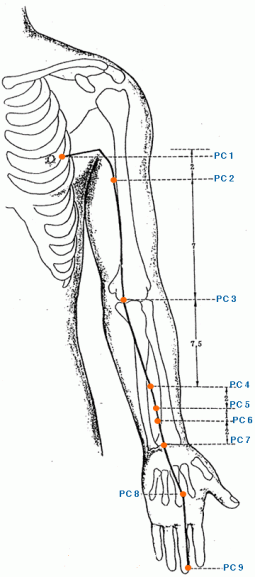
The pericardium channel of the Hand-Jueyin originates in the chest lateral to the nipple. It then ascends to the axillary fossa and runs along the medial aspect of the upper arm, passing through the cubital fossa. It goes further downward to the forearm between the tendons of the m. palmaris longus and m. flexor carpi radialis. It enters the palm and passes along the middle finger to its tip.
PC1 Tianchi
5 cun lateral to the anterior midline or 1 cun lateral to the nipple in the fourth intercostal space. Deep needle not advised.
PC2 Tianquan
2 cun below the anterior axillary fold between the 2 heads of the biceps brachii.
PC3 Quze
On the transverse cubital crease, at the ulnar side of the biceps brachii tendon.
PC4 Ximen
5 cun above the transverse crease of the wrist PC7, between the palmaris longus and flexor carpi radialis tendons, on the line connecting PC3 and PC7.
PC5 Jianshi
3 cun above the transverse crease of the wrist PC 7, between palmaris longus and flexor carpi radialis tendons, on the line connecting PC3 and PC7.
PC6 Neiguan
2 cun above the transverse crease of the wrist PC7, between palmaris longus and flexor carpi radialis tendons, on the line connecting PC3 and PC7.
PC7 Daling
In the middle of the transverse crease of the wrist between palmaris longus and flexor carpi radialis tendons.
PC8 Laogong
On the trnsverse crease of the palm just below where the tip of the middle finger rest when a fist is made. Between the 2nd and 3rd metacarpal bones.
Laogong is a principal point to revive consciousness and calm the spirit. It is particularly useful in the treatment of febrile diseases affecting the Heart that give rise to psycho-emotional disturbances. According to ancient texts it was the Pericardium channel that treated diseases of the Heart. In fact, the Heart had no channel of its own at first. Even though, the Heart channel was added later, Pericardium points are still preferred to treat disorders of the Heart.
In 5 Elements theory both the Pericardium and the Heart are Fire. Laogong is the Fire point on a Fire channel making it particularly suited for clearing fire from the Heart.
Fire may develop in the Heart a number of ways including
i) stagnant Liver Qi
ii) deficient Kidney (water) failing to restrain Heart (fire)
iii) excess of any of the 5 cardinal emotions
iv) febrile diseases
Since the Heart is seen as the residence of spirit (mind), almost any disharmony will give rise to psychological and/or emotional disturbances. Heart excess will give rise to ceaseless laughter, while heart deficiency will give rise to profound sadness.
PC9 Zhongchong
In the center of the tip of the middle finger. For graphing measurement, 0.1 cun posterior lateral to the corner of the nail.
Triple Warmer Meridian Pathway & Point Locations
(TW, TB, SJ) The Hand Lesser Yang (Shao Yang) of the San Jiao 23 points
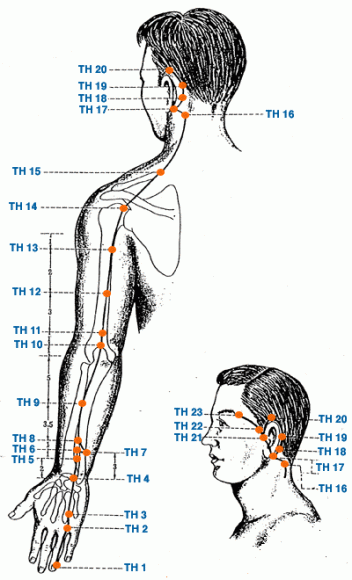
The sanjiao channel of the Hand-Shaoyang originates from the tip of the ring finger. It travels upward between the fourth and fifth metacarpal bones and along the dorsal side of the wrist and the lateral side of the forearm between the radius and ulna, it passes through the olecranon. Then it runs along the lateral aspect of the upper arm and reaches the shoulder region. Crossing over the shoulder, it enters the supraclavicular fossa. It then ascends to the neck, running along the posterior border of the ear. It crosses from the superior aspect of the ear to the corner of the forehead. Then it turns downward to the cheek and terminates In the depression at the lateral end of the eyebrow.
TW1 Guanchong
0.1 cun posterior to the corner of the nail on the ulnar side of the fourth digit.
TW2 Yemen
0.5 cun proximal to the margin of the web between the fourth and fifth digit.
TW3 Zhongzhu
With fist clenched, on the dorsum of the hand between the fourth and fifth metacarpal bones in a depression proximal to the fourth metacarpophalangeal joint.
TW4 Yangchi
On the transverse crease of the dorsum of the wrist between the tendons of muscles extensor digitorum and extensor digiti minimi.
TW5 Waiguan
On the dorsum of the forearm, 2 cun above TW4 between the radious and the ulna.
TW6 Zhigou
On the dorsum of the forearm, 3 cun above the TW4 between the radius and the ulna.
TW7 Huizong
One finger width lateral to TW6 on the radial side of the ulna.
TW8 Sanyangluo
On the dorsum of the forearm 4 cun above TW4 between the radius and the ulna.
TW9 Sidu
On the dorsum of the forearm, 5 cun below the olecranon between the radius and the ulna.
TW10 Tianjing
1 cun superior to the olecranon in a depression formed with the elbow flexed.
TW11 Qinglengyuan
With the elbow flexed, 1 cun above TW10.
TW12 Xiaoluo
5 cun superior to the olecranon on a line midway between TW10 and TW14.
TW13 Naohui
3 cun below TW14 on the posterior border of the deltoid muscle, on the line joining the olecranon and TW14.
TW14 Jianliao
In the depression posterior and inferior to the acromion process, about 1 cun posterior to LI15.
TW15 Tianliao
Midway between GB21 and SI13 on the superior angle of the scapula.
TW16 Tianyou
Posterior and inferior to the mastoid process, on the posterior border of the SCM muscle and level with BL10.
TW17 Yifeng
Posterior to the lobule of the ear in a depression between the mandible and the mastoid process.
TW18 Qimai
In the center of the mastoid process at the junction of the middle and lower third of the curve formed by TW17 and TW20, posterior to the helix.
TW19 Luxi
Posterior to the ear at the junction of the upper and middle third of the curve formed by TW17 and TW20, posterior to the helix.
Gall Bladder Meridian Pathway & Point Locations
The Foot Lesser Yang (Shao Yang) of the Gall bladder 44 points
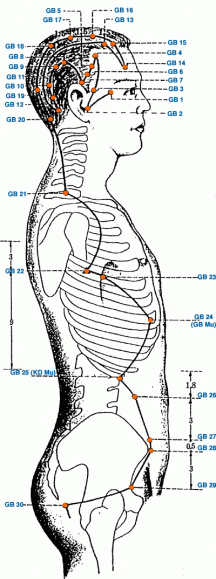
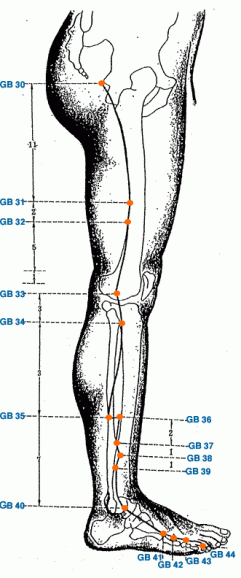
The gall bladder channel of the Foot-Shaoyang starts from the outer canthus of the eye, and desends to the anterior aspect of the ear. Then ascends to the corner of the forehead, and then winds downward posterior to th ear. Then arches forward to the forehead at the midpoint of the eyebrow. It then runs above the hairline to the lateral side of the neck. Travels highest point of the trapezius muscle. From there it further descends to the axilla and enters the chest. It then travels interiorly in the hypochondriac region, emerging at the lateral side of the lower abdomen near the femoral artery in the inguinal region. Then it curves along the margin of the public hair and runs transversely into the hip region. It then travels downward along the lateral side of thigh to the lateral side of the knee. Further descending along the anterior aspect of the fibula, it reaches the lower end of the fibula, and the anterior aspect of the lateral malleolus. Following the dorsum of the foot, it terminates at the lateral side of the fourth toe’s tip.
GB1 Tongziliao
0.5 cun lateral to the outer canthus of the eye in a depression on the lateral side of the orbit.
GB2 Tinghui
Anterior to the intertragic notch at the posterior border of the condyloid process of the mandible with the mouth open.
GB3 Shangguan
Anterior to the ear, in the depression directly above ST7 on the upper border of the zygomatic arch.
GB4 Hanyan
Within the hairline at the junction of the upper 1/4 and lower 3/4 distance between ST8 and GB7.
GB5 Xuanlu
Within the hairline midway between ST8 and GB7.
GB6 Xuanli
Within the hairline at the junction of the lower 1/4 and upper 3/4 distance between ST8 and GB7.
GB7 Qubin
Within the hariline, anterior and superior to the auricle, about 1 cun anterior to TW20.
GB8 Shuaigu
Superior to the apex of the auricle, 1.5 cun within the hairline.
GB9 Tianchong
0.5 cun posterior to GB8, 2 cun within the hairline directly above the posterior border of the auricle.
GB10 Fubai
Posterior and superior to the mastoid process at the junction of the middle 1/3 and upper 1/3 of the curve between GB9 and GB12.
GB11 Touqiaoyin
Posterior and superior to the mastoid process at the junction of the middle 1/3 and lower 1/3 of the curve between GB9 and GB12 .
GB12 Wangu
In the depression posterior and inferior to the mastoid process.
GB13 Benshen
0.5 cun within the hairline on the forehead, 3 cun lateral to GV4. Midway between ST8 and BL4.
GB14 Yangbai
On the forehead directly above the pupil, 1 cun above the midpoint of the eyebrow.
GB15 Toulinqi
Directly above GB14, within the hairline, midway between GV24 and ST8.
GB16 Muchuang
1.5 cun posterior to GB15, 2 cun above the hairline and 2.25 cun lateral to GV22.
GB17 Zhengying
1.5 cun posterior to GB16, 3.5 cun above the hairline and 2.25 cun lateral to GV21.
GB18 Chengling
1.5 cun posterior to GB17, 5 cun above the hairline and 2.25 cun lateral to GV20.
GB19 Naokong
At the upper border of the external occipital protuberance, 2.5 cun lateral and level to GV 17. directly above GB20.
GB20 Fengchi
In the depression created between the origins of the Sternocleidomastoid and Trapezius muscles, at the junction of the occipital and nuchal regions. Lateral and level with GV16.
GB21 Jianjing
Midway between the spinous process of C7 (GV14) and the acromion process at the highest point of the trapezius muscle.
GB22 Yuanye
With the arm raised, 3 cun below the axilla on the midline in the 4th intercostal space, below HT1.
GB23 Zhejin
1 cun anterior to GB 22 in the 4th intercostal space, level with the nipple.
GB24 Riyue
Directly below the nipple in the 7th intercostal space, inferior to LV14.
GB25 Jingmen
On the lateral side of the abdomen, at the lower border of the free end of the 12th rib.
GB26 Daimai
Directly below LV 13 at the free end of the 11th rib level with the umbilicus (CV8)
GB27 Wushu
On the lateral side of the abdomen, anterior to the ASIS, 3 cun below the level of umbilicus, lateral to CV4.
GB28 Weidao
Anterior and inferior to the ASIS, 0.5 cun anterior and inferior to GB27.
GB29 Juliao
In a depression at the midpoint between the ASIS and the greater trocanter of the femur.
GB30 Huantiao
At the junction of the lateral 1/3 and medial 2/3 of the distance between the greater trocanter and the hiatus of the sacrum (GV2)
GB31 Fengshi
7 cun above the transverse popliteal crease on the lateral midline of thigh, where the tip of the middle finger touches when the patient is standing and hands are at their sides.
GB32 Zhongdu
At the lateral side of the thigh 5 cun above the transverse popliteal crease between vastus lateralis and biceps femoris muscles, 2 cun below GB31.
GB33 Xiyangguan
On the lateral side of the thigh 3 cun above the transverse popliteal crease in a depression superior and posterior to the lateral condle of the femur, between the femur and the tendon of biceps femoris.
GB34 Yanglingquan
In a depression anterior and inferior to the head of the fibula.
GB35 Yangjiao
7 cun above the tip of the lateral malleous on the posterior border of the fibula.
GB36 Waiqui
7 cun above the tip of the lateral malleous on the anterior border of the fibula.
GB37 Guangming
5 cun above the tip of the lateral malleous on the anterior border of the fibula.
GB38 Yangfu
4 cun above and slightly anterior to the tip of the lateral malleous on the anterior border of the fibula.
GB39 Xuanzhong
3 cun above the tip of the lateral malleous in a depression between the posterior border of the fibula and the tendons of peroneous longus and brevis muscles.
GB39 is known as the “Influential Point of Marrow”. Located just above the external malleolus. Marrow is generally referred to assisting brain function or to bone marrow itself. In Traditional Chinese Medicine (TCM) bone marrow does not have a relationship to blood formation as it does in Western physiology. Therefore it is not typically used for blood disorders as one might think.
GB40 Qiuxu
Anterior and inferior to the lateral malleous in a depression on the lateral side of the extensor digitorum longus tendon.
GB41 Zulinqi
On the dorsum of the foot, in the depression between the fourth and fifth metatarsal bones.
GB42 Diwuhui
Posterior to the 4th metatarsophalangeal joint between the fourth and fifth metatarsal bones, on the medial side of the tendon of extensor digiti minimi.
GB43 Xiaxi
On the dorsum of the foot between the fourth and fifth metatarsals 0.5 cun proximal to the margin of the web at the junction of the red and white skin.
GB44 Zuqiaoyin
0.1 cun posterior to the corner of the nail on the lateral side of the fourth toe.
Liver Meridian Pathway & Point Locations
The Foot Terminal Yin (Jue Yin) of the Liver 14 points
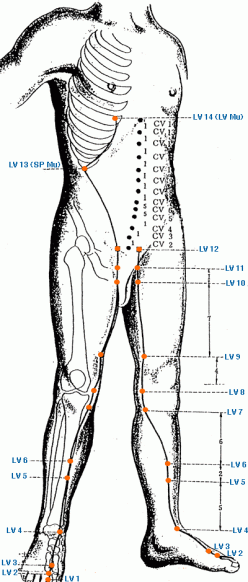
The liver channel of the Foot-Jueyin originates on the lateral side of the great toe. Ascending along the dorsum of the foot, it flows further upward to the anterior aspect of the medial malleolus. Then it runs upward to the medial side of the knee and along the medial aspect of the thigh into the pubic region. From there it curves around the external genitalia and crosses the midline up to the lower abdomen. Ending directly below the nipple.
LV1 Dadun
On the lateral side of the great toe, 0.1 cun from the corner of the nail.
LV2 Xingjian
On dorsum of the foot between the 1st and 2nd toes, proximal to the margin of the web at the junction of the red and white skin.
LV3 Taichong
On dorsum of the foot in a depression distal to the junction of the 1st and 2nd metatarsal bones.
LV4 Zhongfeng
1 cun anterior to the medial malleolus, midway between SP5 and ST41, in a depression on the medial side of the tendon of tibialis anterior.
LV5 Ligou
5 cun above the tip of the medial malleolus on the medial side of the tibia.
LV6 Zhongdu
7 cun above the tip of the medial malleolus and posterior to the medial tibia.
LV7 Xiguan
1 cun posterior to SP9, posterior and inferior to the medial condyle of the tibia in the upper portion of the medial head of the gastrocnemius muscle. In the depression of the medial border of the tibia.
LV8 Ququan
When the knee is flexed, the point is found above the medial end of the transverse popliteal crease, posterior to the medial epicondyle of the tibia in a depression on the anterior border of the insertions of the semimembraneous and semitendoneous muscles.
LV9 Yinbao
4 cun above the medial epicondyle of the femur, between vastus medialis and sartorius muscles.
LV10 Zuwuli
3 cun below ST30 at the proximal end of the thigh on the lateral border of adductor longus muscle.
LV11 Yinlian
2 cun below ST30, 2 cun from the midline at the proximal end of the thigh and on the lateral border of adductor longus muscle.
LV12 Jimai
2.5 cun lateral and inferior to the superior border of the pubic symphysis. In the inguinal groove lateral and inferior to ST30.
LV13 Zhangmen
On the lateral side of the abdomen below the free end of the 11th rib.
LV13 is known as the “Influential Point of the Viscera”. Located at the tip of the 11th rib, this point is known as the Alarm point of the Spleen. In my opinion, it is one of the premier points on the body affecting anything of visceral symptomatolgy. This point when used with BL 38 (on the vertebral border of the scapula half way between the top and bottom) is legendary for patients with visceral complaints regardless of its origin. The Spleen meridians relationship to the Extraordinary meridians is one of the most important relationships in the body.
This point is critical.
LV14 Qimen
Directly below the nipple, 4 cun lateral to the midline in the 6th intercostal groove
Governing Vessel Meridian Pathway & Point Locations
The Governing Channel has 28 points
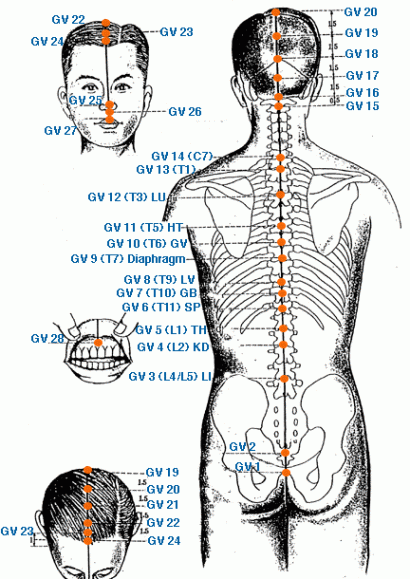
The Du channel starts midway between the tip of the coccyx bone and the anus with patient lying prone. It then flows upward inside the spinal column to the nape of the neck, and ascends to the vertex. Along the forehead, it descends to the nose bridge, then to the lips. Ending at the labial frenulum inside the upper lip.
GV1 Changqiang
Midway between the tip of the coccyx bone and the anus with patient lying prone.
GV2 Yaoshu
In the sacral hiatus.
GV3 Yaoyangguan
Below the spinous process of L4
GV4 Mingmen
Below the spinous process of L2
GV5 Xuanshu
Below the spinous process of L1
GV6 Jizhong
Below the spinous process of T11
GV7 Zhongshu
Below the spinous process of T10
GV8 Jinsuo
Below the spinous process of T9
GV9 Zhiyang
Below the spinous process of T7
GV10 Lingtai
Below the spinous process of T6
GV11 Shendao
Below the spinous process of T5
GV12 Shenzhu
Below the spinous process of T3
GV13 Taodao
Below the spinous process of T1
GV14 Dazhui
Below the spinous process of C7
GV15 Yamen
0.5 cun above the midpoint of the posterior hairline in a depression below the spinous process of C1
GV16 Fengfu
1 cun directly above the midpoint of the posterior hairline directly below the external occipital protruberance. In the depression between the trapezius muscles of both sides.
GV17 Naohu
Midway between GV16 and GV18, 1.5 cun above GV16
GV18 Qiangjian
Midway between GV16 and GV20, 1.5 cun above GV17
GV19 Houding
5.5 cun above the midpoint of the posterior hairline. Midway between GV18 and GV20, 1.5 cun above GV18
GV20 Baihui
7 cun above the midpoint of the posterior hairline, 5 cun above midpoint of anterior hairline, miway on a line connecting the apex of both ears.
GV21 Qianding
1.5 cun anterior to GV20. Midway between GV20 and GV22.
GV22 Xinhui
2 cun posterior to the anterior hairline, 3 cun anterior to GV20
GV23 Shangxing
1 cun posterior to the anterior hairline, 0.5 cun posterior to GV24
GV24 Shenting
0.5 cun above the midpoint of the anterior hairline.
GV25 Suliao
On tip of nose
GV26 Renzhong
At junction of the upper and middle third of philtrum.
GV27 Duiduan
At junction of upper lip and philtrum.
GV28 Yinjiao
At junction of gum and frenulum of upper lip.
Conception Vessel Meridian Pathway & Point Locations
The Directing Channel has 24 points

The Ren channel starts on the midline between the anus and the scrotum in males. Between the anus and the posterior labial commissure in females. It ascends anteriorly to the public region. Along the midline of the abdomen, it flows upward reaches the throat. Flowing further upward, it ends in the depression in the center of the mentolabial groove.
CV1 Huiyin
On the midline between the anus and the scrotum in males. Between the anus and the posterior labial commissure in females.
CV2 Qugu
On top of the notch in the center of the superior border of the pubic symphysis.
CV3 Zhongji
1 cun above CV2, on the midline, 4 cun inferior to the umbilicus.
CV4 Guanyuan
on the midline, 3 cun inferior to the umbilicus.
CV5 Shimen
On the midline, 2 cun inferior to the umbilicus.
CV6 Qihai
On the midline, 1.5 cun inferior to the umbilicus.
CV7 Yinjiao
On the midline, 1 cun inferior to the umbilicus.
CV8 Shenque
In the center of the umbilicus
CV9 Shuifen
On the midline, 1 cun superior to the umbilicus.
CV10 Xiawan
On the midline, 2 cun superior to the umbilicus.
CV11 Jianliao
On the midline, 3 cun superior to the umbilicus.
CV12 Zhongwan
On the midline, 4 cun superior to the umbilicus.
CV13 Shangwan
On the midline, 5 cun superior to the umbilicus.
CV14 Juque
On the midline, 6 cun superior to the umbilicus.
CV15 Jiuwei
On the midline, 7 cun superior to the umbilicus and inferior to the xiphoid process.
CV16 Zhongting
On the midline level with the 5th intercostal space at the sternocostal angle.
CV 17 Shanzhong
On the midline level with the 4th intercostal space midway between the nipples.
CV 17 (Ren Mai) is known as the “Influential Point of Chi”. Known as the Mu / Alarm point for the Pericardium / Circulation/Sex meridian it is particularly related to the lungs. Located two inches above the xiphoid process. It is often used for conditions affecting the lungs and heart. This point has numerous applications, as it is also the 4th Chakra in addition to being a point that would have major affects on hormonal effects due to its relationship to the Pericardium meridian.
CV18 Yutang
On the midline level with the 3rd intercostal space.
CV19 Zigong
On the midline level with the 2nd intercostal space.
CV20 Huagai
On the midline level with the 1st intercostal space.
CV21 Xuanji
On the manubrium midline, 1 cun below CV22
CV22 Tiantu
0.5 cun superior to the suprasternal notch, in the center of the depression.
CV23 Lianquan
On the midline, in the depression superior to the hyoid bone.
CV24 Chengjiang
In the depression in the center of the mentolabial groove, below the middle of the lower lip.
The Eight (Hui) Influential Points
Without question some of the most “Influential Points” on the body are named accordingly. These particular acupuncture points exert a profound effect on the functioning of the body. Each of them have a specific systemic effect on a particular tissue, body area or organ system.
Because illness may generally assert an effect on multiple sights in the body, the “Influential points” have a practical effect by eliminating superfluous needle stimulation and focusing the treatment on as few points as possible. A classic example would be the influential point known as GB 34 just in front of the tibial tuberosity. This point is the classic point for any symptomatology affecting the “sinews”. Therefore, any symptom dealing with muscles, ligaments, tendons have a positive effect by the stimulation of GB 34.
Regardless of where the musculoskeletal condition is located, GB 34 will have a positive effect. The person may be suffering with rotator cuff syndrome or epicondylitis in each case, the influential point for the “sinews” will have a particular effect even though it is far removed from the sight of discomfort. Most often, practitioners will utilize local points in the area of pain in addition to GB 34.
GB 39 is known as the “Influential Point of Marrow”. Located just above the external malleolus. Marrow is generally referred to assisting brain function or to bone marrow itself. In Traditional Chinese Medicine (TCM) bone marrow does not have a relationship to blood formation as it does in Western physiology. Therefore it is not typically used for blood disorders as one might think.
It has a particular effect on both sciatic neuritis as well as cervicalgia due to its being a specific point linking the yang meridians of the lower extremity, namely Gallbladder, Stomach and Bladder. Remember, a meridian effects what it is named after and where it courses to. It has also been used for vertigo and brain dysfunction.
LU 9 is known as the “Influential Point of the Vessels”. This point is often used in order to assist the pulse stand out more clearly in those with fine and weak pulses when using pulse diagnosis. It has been used in cardiovascular disease. However, its ancient claim to fame is for conditions affecting the pulse.
BL 11 is known as the “Influential Point of Bone”. Two fingers breadth bilateral to C7-T1. Probably one of the most controversial points on the body due to the fact it does indeed have an effect on bone, but primarily due to its effect with pathogenic wind. When a patient complains of bone symptomatology due to attack of pathogenic wind as in “bi patterns” this point has a particularly high effect rate. However, it must be borne in mind, additional points such as BL 12, GB 21, TH 15 have very similar effects.
BL 17 is known as the “Influential Point of Blood”. Two fingers breadth bilateral to T5-6. This point is one of the classic points especially effective in any condition involving blood. It deals with blood stasis. In classical osteopathy, Andrew Taylor Still stated, “the rule of the artery is supreme”, this acupoint deals with any condition dealing with blood. Anytime pain is a factor, blood will be involved. Think of this point as one of the most important points on the body.
CV 17 (Ren Mai) is known as the “Influential Point of Chi”. Known as the Mu / Alarm point for the Pericardium / Circulation/Sex meridian it is particularly related to the lungs. Located two inches above the xiphoid process. It is often used for conditions affecting the lungs and heart. This point has numerous applications, as it is also the 4th Chakra in addition to being a point that would have major affects on hormonal effects due to its relationship to the Pericardium meridian.
CV 12 (Ren Mai) is known as the Influential Point of the Bowels”. Located half way between the umbilicus and the xiphoid process, this point is the Alarm point for the Stomach. It is perhaps one of the most significant points on the body for any stomach or bowel symptomatology. It has an effect on the Spleen meridian.
Liv 13 is known as the “Influential Point of the Viscera”. Located at the tip of the 11th rib, this point is known as the Alarm point of the Spleen. In my opinion, it is one of the premier points on the body affecting anything of visceral symptomatolgy. This point when used with BL 38 (on the vertebral border of the scapula half way between the top and bottom) is legendary for patients with visceral complaints regardless of its origin. The Spleen meridians relationship to the Extraordinary meridians is one of the most important relationships in the body. This point is critical.
GB 34 is known as the “Influential Point of the Sinews”. Located just in front of the tibial tuberosity, this point is one of the classic points on the body for any condition affecting muscles, ligaments and tendons. It is one of the most historically used points for thousands of years in every Asian nation.
The eight points you have been presented with here are extremely powerful. You will find these points an incredible addition to a clinical practice. Strong caution is urged when using needle stimulation as some of these points are in sensitive and potentially dangerous areas. Remember, “Acupuncture is a principle not a technique”, therefore, many techniques can be safely utilized to include, laser and electronic stimulation.
Spinal Hua Tuo Points
These classic points are located just half a cun, or human inch (the distance across the widest part of the patient’s thumb) bilateral to Du Mai (GV) (midline over the vertebral spinous process) from T1 through L5. Classically there are 17 pairs of points (34 points total) attributed to Hua Tuo. Within the last 2,000 years, these points have extended both upward through the cervical spine and downward across the sacrum. The points in the cervical and sacrum are simply known as jia (lining) ji (spine).
Learn more about: Dim Mak and George Dillman
Quick Links
- Home
- About Us
- Water Element- Self Urine Therapy
- About Urine Therapy
- Introduction
- Urine Test
- Scientific Information
- How to Do Urine Therapy
- Information on Urine Therapy
- WORLD CONFERENCE ON URINE THERAPY
- VDO on 6th world conference
- HEALTH CENTERS AND WEB SITES ON UT
- BOOKS ON URINE THERAPY
- AUDIO ON URINE THERAPY
- VIDEO ON URINE THERAPY
- PICTURES on UT
- Urine Therapy Federation of India
- Members of UTFI
- Pictures UTFI
- SELF EXPERIENCES & CASE HISTORY
- Common Questions
- Urine Therapy By
- Natural Healing by Sunil Munot
- UT BY COEN VAN DER KROON
- UT BY MARTHA CHRISTY
- UT BY MARTIN J LARA
- UT BY SWAMI SATYANANDA SARASWATI
- UT BY DEVENDRA VORA, M.D.
- UT by Mike Crowley
- UT By Renee Sunsprit
- UT BY NATALIA PERERA
- UT BY FLORA PESCHEK-BÖHMER PH.D.
- UT BY BIOMEDX
- UT BY DR.G.K.THAKKAR – SHIVAMBU GITA
- UT BY SHIRLEYSWELLNESSCAFE.COM
- UT BY JOHN F. KELLY
- UT BY AHMEN HEAVEN
- UT BY AGAMA YOGA
- UT BY WALTER LAST
- UT BY ALLDEAF.COM
- UT By Cameron Karsten
- Ut by Damar Tantra
- UT By Tony Scazzero
- UT Information by Don Orina
- Best Drinking Water
- SEA WATER
- About Urine Therapy
- Earth Element
- Fire Element
- Air Element
- Sky Element
- Sixth Element
- Chronic Diseases
- Cleaning Elements
- Important links
- Jain links
- Visitors Mail
- Gallery
- Video
- Our Inspiration
- Contribution
- Contact Us

